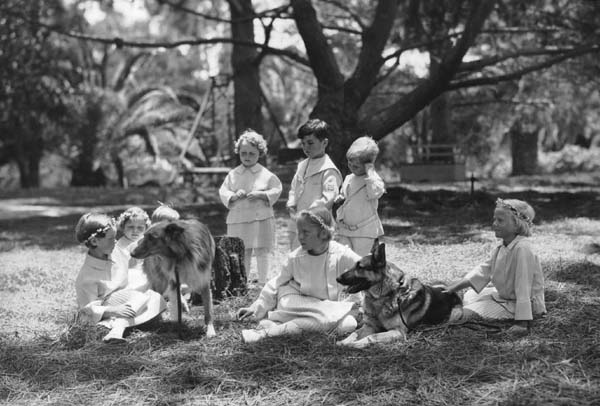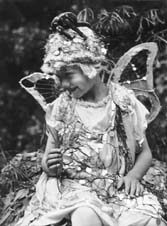
Several decades ago a Scottish friend turned to me when we were in a group, chatting, and said: "One of these days you will be among the few who can say, 'I remember KT'." Of course there are still a number of us today who attended the Raja-Yoga School and have some recollection of Katherine Tingley.
I was born about eight years before her death, so I can recall only the latter years of her time, yet the mid-1920s were dynamic and left me with deep impressions. Dredging up memories from long ago and evaluating the experience in relation to more recent cycles has been challenging and at the same time stimulating.
Yes, I do remember KT: she had a commanding presence that stays with one, and as children we always referred to her as Madame Tingley. Our group of girls went to see her fairly often, and brought her flowers. Sometimes she had her Pekingese dog, Dixie, with her, which we enjoyed. KT loved animals, and many members living on the grounds had dogs, cats, and birds.
The idea of brotherhood -- especially the divine oneness of life and consideration of others -- was implicit in the curriculum. At a very early age we learned how to spell the word and to say, "Helping and sharing is what brotherhood means." Also when very young we were taught to identify the various nations and their flags, and sang songs in German, Swedish, Spanish, and French, besides English. This was a natural development as there were children of various nationalities in the school.
The necessity for concentration was also emphasized -- the importance of focusing completely on the job being done. One of the first words we learned to spell was Attention. Mental arithmetic was stressed to keep the mind alert, also reading out loud and spelling bees. A discipline in concentration came when we practiced piano in a music room with seven upright pianos in it, all in operation with students playing different compositions. It was indeed a surprise to hear how one's pieces really sounded when alone at a piano lesson away from the din in the music room.
One of my happy memories was hearing in the evening the practice sessions of the adult orchestra and chorus in the rotunda of the Academy building where we lived on the second floor. We had gone to bed by this time, and I used to open the door a crack, as my bed was near it, so I could hear them rehearsing. In this way I became familiar with many of the classical compositions.
KT believed that everyone has a duty to fulfill in life, and that it is never too early to learn individual responsibility. In fact, it is recognized today that children learn quickly at a very early age. "Doing one's duty" was an important theme throughout the educational program. Every day we made our beds and had various chores to do. One of my jobs was looking after our teacher's canary. Once when I had the cage outdoors on the porch so the bird could enjoy the sun, I let the cage door open too far and the bird flew out immediately, aiming for the highest tree. Fortunately, after enjoying its freedom through the day it thought better of spending the night outdoors and returned to the cage -- much to my relief, and that of my teacher.
The educational system at the Raja-Yoga School was a multi- dimensional effort. Since raja-yoga literally means "kingly union" of the various faculties, the educational system encompassed a broad spectrum: not only the mental potential, but the creative, artistic, and soul qualities as well. This breadth of purpose attracted world attention, and educators from various parts of the world came to discover what Katherine Tingley was accomplishing.
As I reflect on all this today, I can readily understand KT's intent to plant seed ideas appealing to the inner nature of each child, which would grow and deepen in meaning through the years. For example, we said daily before meals, "Truth, Justice, Silence." Even though we tended to say the words very quickly and run them all together as children will do, these keynotes have stayed with me and, of course, their significance has increased through the years. Before the evening meal we recited the following:
Let us end the day with more power of thought for self-conquest than we had at the beginning of the day. Let us close our eyes tonight with a clean conscience, and with a feeling of generous love for all that breathes, which is the best side of our natures. Let us seek more knowledge, more light, more strength, in the silence of our last thoughts before retiring.
Times of relaxation and pleasure were not ignored. A birthday, especially with the girls, was a festive occasion. We were in a sense "queen for a day" and wore a wreath of flowers, often made with fern, small pink roses, and forget-me-nots. Considerable time was spent outdoors. On recess breaks we enjoyed scooters, tricycles, etc., and sometimes played hide and seek, or hopscotch. In the afternoon we went to the playground where there were bars, rings, and swings. In the springtime we looked forward to long walks in the fields outside the Headquarters grounds to gather yellow violets and shooting stars, and again to the hillsides near the beach to pick wild maidenhair fern. Frequently we walked on the grounds, which were beautiful, and the teachers who took us around told us the names of the plants and trees: flowering eucalyptus, varieties of pine, palm, and acacia, a small ice-plant called mesembryanthemum (we all learned how to say this, and even to spell it!), and many others.

Children at Point Loma, about 1928
Often pleasure and work mingled, as when we gathered in the pine grove near the Academy building and helped shell peas and lima beans, or prepare stringbeans brought up in big crates from the kitchen. Many of the fruits and vegetables we had daily were grown in the Headquarters orchards and vegetable gardens.
We particularly enjoyed the arts and crafts class conducted by Hazel Pool, a very creative person who made learning a pleasure. She taught us how to make baskets with pine needles that we helped collect on our grounds. The pine needles were soaked in water to become pliable, and kept damp. Then clusters were rounded and sewn with raffia which Mrs. Pool had dyed in bright colors. We did various types of hand work as presents for our families, and while we worked Mrs. Pool read us stories. Once in a while we went to her home: she had a beautiful garden and allowed each of us to pick a few of the pansies to take back with us. We also loved working the expertly crafted wooden jigsaw puzzles which Mr. Pool made.
Christmas and Easter were special occasions. Near the Academy building we went for the Easter Egg Hunt in a garden with a narrow winding path of rounded beach stones called The Dragon Path, which we loved, made by our Welsh member, Kenneth Morris. It had a low wall of stones and the vegetation all around made it an ideal place for hiding brightly colored eggs.
Christmas Eve included a big celebration in the rotunda of the Academy building where we had a fine stage. Everyone awaited the magical appearance of the lighted Christmas tree gradually lowered from the second floor in the darkness as the chorus sang Silent Night. Then Santa Claus arrived with his sack. One year when he opened it, I appeared, dressed in a Swedish costume. The first time I was about 3 years old, and I did it the next two years as I recall. One time the bag was whirled down to the floor a little too quickly, and I saw four stages instead of one! Fortunately I was able to stay on my feet and wish everyone a Merry Christmas.
Another type of special event was the Wednesday evening concert which occurred about once a month. Aside from our usual school studies, our children's chorus learned action songs which we sang at the concert. One time four Russian singers with magnificent voices were invited by KT to sing for everyone, and they in turn were guests at one of our concerts in the Temple of Peace. They sat in the front row with Katherine Tingley, and four of us were chosen to pin a boutonniere on the lapel of each of them. I'll never forget my surprise when I attempted to insert the pin in the singer's lapel and the fabric was so substantial that I succeeded only in bending the pin in half! The singer graciously took the boutonniere and fixed it without the pin.
On occasions such as Mme. Tingley's birthday on July 6, we gathered on the picnic grounds near the Headquarters building -- a clearing surrounded by trees. The band played and there was a picnic lunch followed by festivities.
One of the memories most meaningful to me was participating in A Midsummer Night's Dream. I can remember Katherine Tingley sitting sometimes in the top row of the Greek Theater directing it. We could hear her voice, but Iverson Harris came down the many steps to be sure her instructions were understood. I was also in Shakespeare's Tempest, but A Midsummer Night's Dream was special to me because I had a part to say in it. I was Cobweb, in a grayish costume with black open-work material over it, and a cap with a big black velvet spider on top of it. My sister was First Fairy. It was fascinating to wait in the Annex -- a building somewhat removed from the theater -- sitting quietly until our turn to appear, having our make-up taken care of and watching some of the key actors transformed by the make-up artist.

Author as Cobweb
On performance nights the Greek Theater took on a magical atmosphere. Lighted Japanese lanterns led up to the theater, the musicians in the orchestra pit played, and the lighting was impressive. After the performance we were given a hot drink and crackers before going to bed. So many glimpses come to mind of different experiences, it is still difficult to evaluate them in their full dimension.
There was obviously a tremendous force behind the vision that Katherine Tingley had in establishing the School for the Revival of the Lost Mysteries of Antiquity, which attracted gifted people from countries near and far. There must have been karmic connections that drew so many there. My father and mother came from Sweden, for example, but at different times, and met at Point Loma. Unfortunately I never knew my father well because he died when I was only four.
The ideals were high, but the carrying out of them was of course subject to human error, some teachers in the School being more highly qualified in character and training than others. But may we not say that in any school one's feeling about different teachers varies? By and large I am deeply grateful for the experience, as are many of my friends with whom I have kept in touch. We did not know then the uniqueness of the situation, and realized more of the inner intent only as the years passed.
As for our parents, they made sacrifices in order that we might have this training. We visited them regularly when they lived near enough. It was far more difficult both for the students and the parents when the parents lived abroad. All in all, I for one feel that the experience was a rare opportunity.